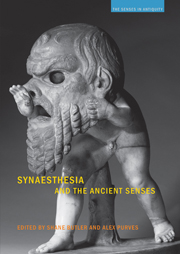Book contents
- Frontmatter
- Contents
- Contributors
- Introduction: synaesthesia and the ancient senses
- 1 Why are there nine Muses?
- 2 Haptic Herodotus
- 3 The understanding ear: synaesthesia, paraesthesia and talking animals
- 4 Aristophanes, Cratinus and the smell of comedy
- 5 “Looking mustard”: Greek popular epistemology and the meaning of δριμύς
- 6 Plato, beauty and “philosophical synaesthesia”
- 7 Manilius' cosmos of the senses
- 8 Reading death and the senses in Lucan and Lucretius
- 9 Colour as synaesthetic experience in antiquity
- 10 Blinded by th light: oratorical clarity and poetic obscurity in Quintilian
- 11 The sense of a poem: Ovids Banquet of Sence (1595)
- 12 Saussure's anaphonie: sounds asunder
- 13 Beyond Narcissus
- Bibliography
- Index
3 - The understanding ear: synaesthesia, paraesthesia and talking animals
- Frontmatter
- Contents
- Contributors
- Introduction: synaesthesia and the ancient senses
- 1 Why are there nine Muses?
- 2 Haptic Herodotus
- 3 The understanding ear: synaesthesia, paraesthesia and talking animals
- 4 Aristophanes, Cratinus and the smell of comedy
- 5 “Looking mustard”: Greek popular epistemology and the meaning of δριμύς
- 6 Plato, beauty and “philosophical synaesthesia”
- 7 Manilius' cosmos of the senses
- 8 Reading death and the senses in Lucan and Lucretius
- 9 Colour as synaesthetic experience in antiquity
- 10 Blinded by th light: oratorical clarity and poetic obscurity in Quintilian
- 11 The sense of a poem: Ovids Banquet of Sence (1595)
- 12 Saussure's anaphonie: sounds asunder
- 13 Beyond Narcissus
- Bibliography
- Index
Summary
WAGNER, POETRY AND THE EYE OF HEARING
Synaesthesia, as a goal for the arts, has meant the production of simultaneous aesthetic experiences in more than one of the senses, even if the artwork that aims at producing these experiences exists only in a single medium. Among nineteenth-century French poets, for example, Baudelaire, in his sonnet “Correspondances”, spoke of equivalences between sound, smell and colour, such that the sound of poetry composed with these equivalences in mind might produce complementary olfactory or visual experiences in the listener. Rimbaud, in his sonnet “Voyelles”, went so far as to offer a primer for this aesthetic labour by colouring in the vowels of the French language for future use: A is black, E white, I red, U green and O blue. In this version of synaesthesia, each of the senses is conceived as a single faculty, and the aesthetic experience it enables as unitary. A synaesthetic poem produces sounds for hearing, colours for seeing, and smells (fragrances, usually) for smelling, and these sensations are harmonious when they happen together because of a natural affinity between them.
From this perspective, the appeal of Richard Wagner's opera for French poetic theorists of synaesthesia is easy to understand. The idea that opera is a total work of art in which music, spectacle and libretto complement one another would seem to fully realize their ambitions for an artistic sensorium in which complementary aesthetic experiences happen simultaneously.
- Type
- Chapter
- Information
- Synaesthesia and the Ancient Senses , pp. 43 - 52Publisher: Acumen PublishingPrint publication year: 2013



